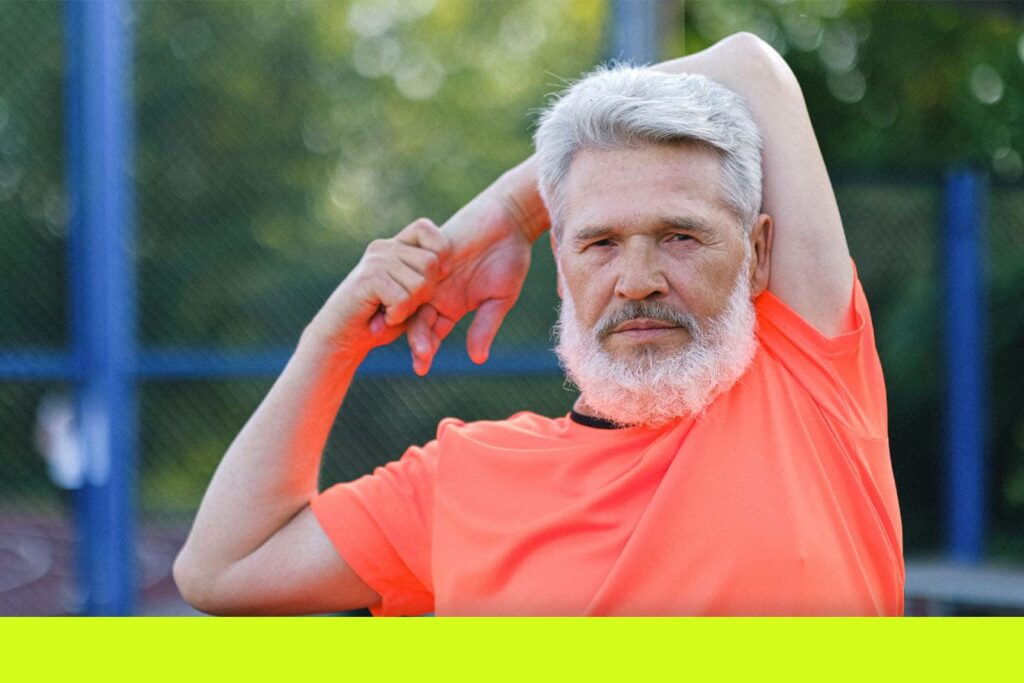
Therapeutic exercise for the elderly - how to do it at home
Therapeutic exercise for the elderly after 60: basics and benefits
Therapeutic exercise is a set of exercises aimed at treating and preventing diseases. They also contribute to the rehabilitation of patients after injuries and illnesses – stroke, heart attack or hypertensive crisis. Adaptive physical education, aimed at improving the well-being of patients with limited mobility, plays an important role.
Therapeutic exercise includes walking, swimming, training on specialized exercise machines, as well as physiotherapy procedures and massage. These types of activity have a positive effect on health:
- strengthening muscles, improving coordination, which reduces the risk of falls and injuries;
- stabilizing blood pressure, improving blood circulation and preventing heart disease;
- supporting the immune system;
- maintaining flexibility and mobility of joints – helps prevent and relieve symptoms of arthritis, osteoarthritis;
- stimulation of the production of endorphins – hormones that improve mood and help fight depression and anxiety, and normalize sleep.

Features of therapeutic physical training for elderly people after 60+
Before you start, you need to consult a doctor. Therapeutic exercise programs are developed individually, taking into account unique characteristics, health, level of physical fitness and possible limitations.
In the exercise program for elderly people over 60, special attention is paid to warm-up and relaxation – they account for more than 60% of the time. After classes, it is recommended to devote about 90 minutes to rest in a calm environment, and also take breaks between approaches.
Static exercises that require prolonged tension and intense strength training are not recommended. It is contraindicated to exercise in case of poisoning, acute pain, high temperature, infectious and inflammatory diseases in the acute stage, embolism, thrombosis, malignant neoplasms and metastases, mental disorders, as well as the risk of bleeding.
Goals - improving coordination and balance, endurance, as well as strengthening muscles and joints.
Morning is the optimal time for exercise for grandparents after 70 years. It helps to activate the body, improve blood circulation and tune in to a productive day. If after sleep a person feels discomfort or lack of energy, you can move the exercises to a later time, for example, to the afternoon.
You should start with breathing exercises for a warm-up, then move on to the main part, gradually increasing the intensity.

Breathing exercises
Breathing exercises for the elderly over 60 years old help to increase lung capacity and prevent respiratory diseases. It can also relieve stress and improve sleep quality.
Exercise examples:
- deep slow breaths in and out, performed lying down or sitting with a straight back;
- long inhalation through the nose using the diaphragm, exhalation through the mouth. In this case, the chest remains motionless;
- slow maximum inhalation with filling the lungs with air, then slowly exhaling through the mouth, while pursing the lips.
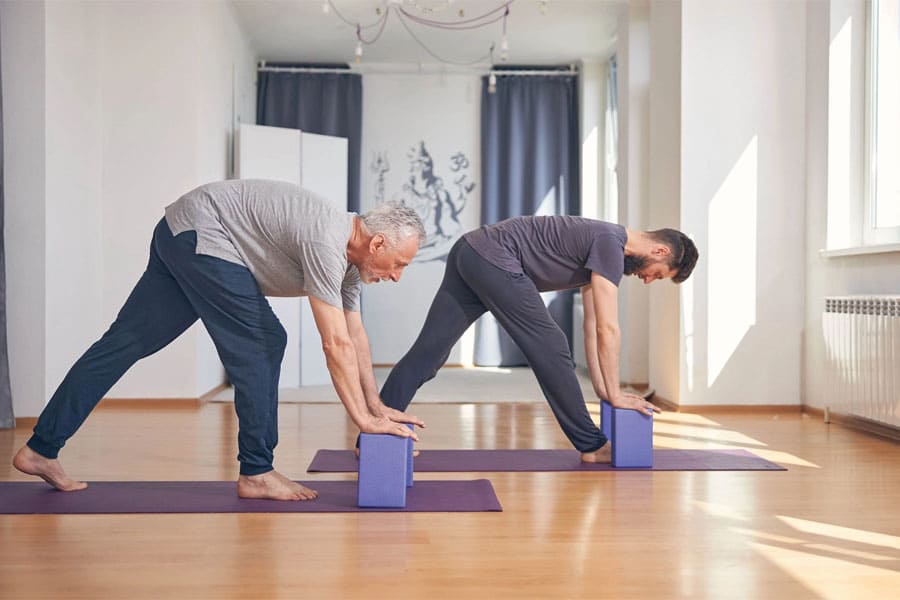
Maintaining mobility and flexibility of joints
Joint gymnastics for elderly people over 70 years old is especially useful, but doctors recommend it to everyone with excess weight, problems with the musculoskeletal and cardiovascular systems.
Exercises relieve joint pain and maintain their mobility:
- head tilts forward, turns to the sides;
- rotation of the shoulders forward and backward;
- circular rotations of the pelvis;
- side bends with raising the opposite arm;
- alternating forward bends to each leg;
- turning the upper body to the sides;
- squeezing and relaxing the hands;
- raising arms bent at the elbows;
- sitting on a chair – rolling your feet from heel to toe, rotating your feet and shins, stretching your toes forward;
- alternating moving your arms behind your back to reach your shoulder blade with your palm;
- raising and lowering your forearms.
The execution should be smooth, without haste, it is necessary to avoid pain and discomfort. At the initial stage, it is enough to do 5-7 repetitions.
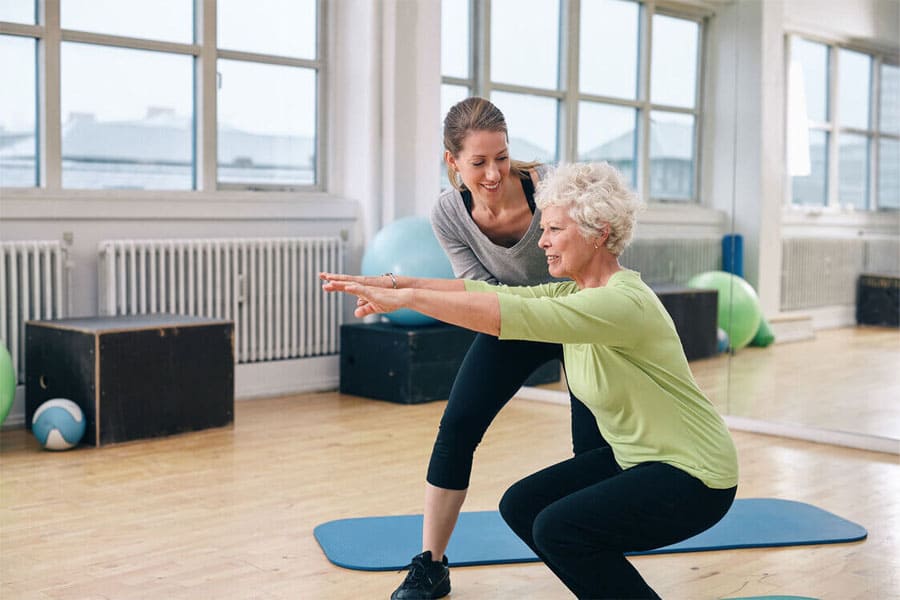
Muscle strengthening
When the muscles are toned, it is easier to walk and maintain balance – this reduces the risk of falls. Strengthening the muscles also helps maintain a healthy weight and speed up the metabolism.
Exercise examples:
- squats. Feet shoulder-width apart, heels on the floor, knees and feet on a line perpendicular to the floor;
- walking in place with raised knees;
- alternating lifting of bent legs – standing, leaning on a chair or wall;
- alternating lifting and breeding of arms with dumbbells or elastic bands.
It is recommended to do 10-15 times to achieve the optimal effect. If discomfort occurs, stop immediately.
Balance and coordination training
Exercise for the elderly over 70 years old should include a complex for developing balance and coordination.
This has a positive effect on the functioning of the brain and helps prevent falls:
- walking in a straight line;
- transferring body weight from one leg to the other;
- steps to the sides, forward and backward;
- passing the ball from one palm to the other behind the back;
- rising on toes with closed eyes – with support;
- rolling the ball from one foot to the other.
It is optimal to do 10 repetitions.
Strengthening the heart and blood vessels
For the normal functioning of the cardiovascular system, it is necessary to ensure sufficient oxygen supply to the body. Aerobic exercise copes with this task. The key point is to maintain a moderately intense heartbeat.
The maximum pulse (MP) is calculated as follows:
- for women: MP = 209 – (0.9 × age);
- for men: MP = 214 – (0.8 × age).
It is recommended that the pulse be no higher than 50-60% of the obtained value.
You can strengthen the cardiovascular system both in the gym and outside:
- walking – about an hour three times a week. It is important to choose a safe place for walks, comfortable clothes and properly selected shoes;
- swimming is one of the least traumatic sports, as the load on the musculoskeletal system is reduced in water;
- light exercise on a stationary bike and treadmill. A person should feel comfortable and not experience a lack of air. It is necessary to train with an instructor who monitors the intensity of the load, breathing and pulse rates
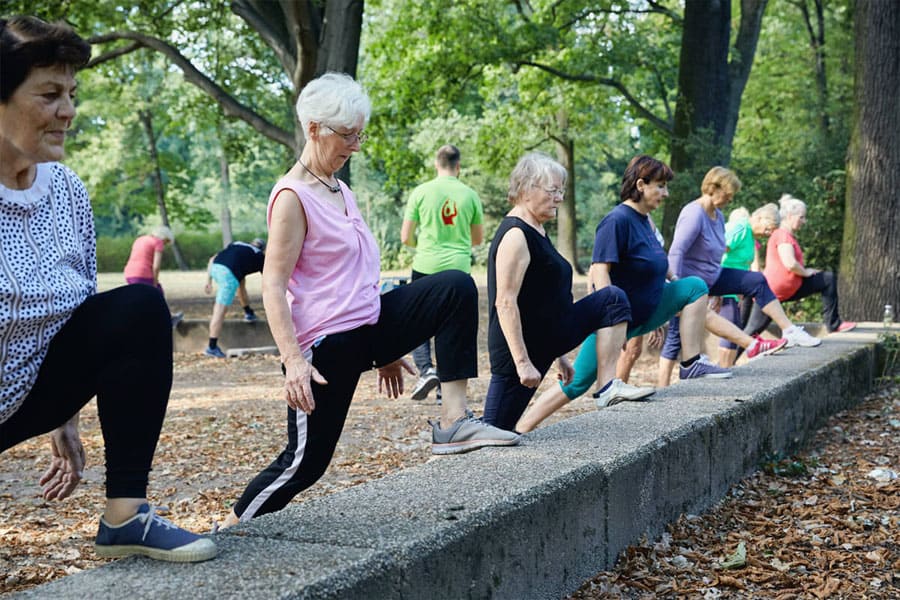
Stretching
This stage is necessarily included in the exercises for pensioners. It promotes the development of joint flexibility, helps prevent injuries and relieve muscle tension.
Stretching should be done slowly and carefully to avoid ligament injuries. It is important to take a short pause during each element:
- turn your head left and right – sitting with a straight back;
- bend your knees to your chest and hug your arms – lying on your back;
- bend your body to your knees – sitting on the floor.
The optimal number of repetitions is 5 times.
Often, elderly people cannot force themselves to do physical exercise, they are embarrassed in the presence of their relatives. Sometimes they lack company or support.
Special groups or boarding houses for the elderly will help increase motivation to do physical exercise. They support each other, try to keep up with the others, and share their personal achievements and successes with the participants.
